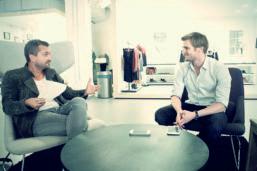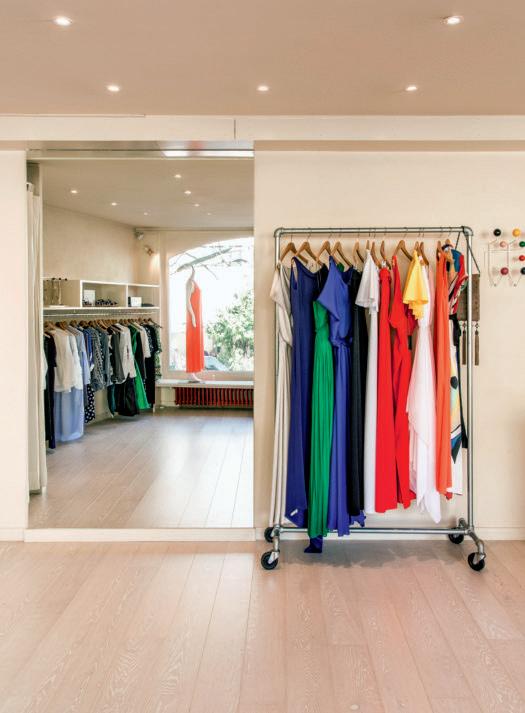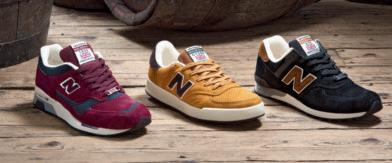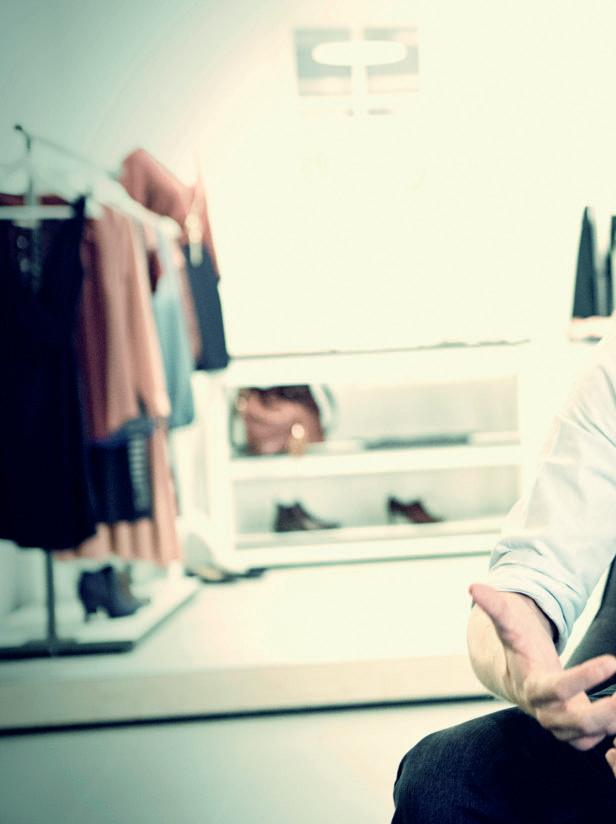
14 minute read
The Vision is to Link Everything
“The Vision is
to Link Everything”


David Schneider (pictured) and Robert Gentz founded Zalando in 2008 and turned the company into Europe’s largest online retailer.
In terms of entrepreneurship, it is an American Dream we Europeans don’t know in this form. After a failed company in Mexico and after returning to Germany empty-handed, Robert Gentz and David Schneider, who became friends at university, decided to try one more time. Within seven years, they transformed a small start-up into a billion Euro corporation listed on the MDAX: Zalando. While being perceived as an all-devouring cannibal by stationary retailers, the e-commerce giant has undergone substantial change. What was merely flashy and loud at the beginning, has grown into a real platform for fashion. David Schneider, now a management board member at Zalando, sat down with style in progress to explain how he wants to shape the future with a young team, extreme agility, and the possibilities of technology, as well as to point out where the boundaries of the digital world touch on real life. Interview: Stephan Huber, Quynh Tran. Photos: Bernhard Musil
What is your most memorable shopping experience?
Especially when we talk about how we strive to develop in the future, one experience is particularly memorable. We had a meeting with Adidas and I needed to get my hands on a pair of Adidas shoes on the same day. I was, of course, much too late; even we couldn’t have delivered those shoes in time. So I started looking around to see where I could get the shoes on such short notice. I ran around Berlin and ultimately found myself in the Adidas store, where I ultimately bought a completely different pair than the one I initially wanted. That’s when I started thinking about how one could meet such a demand more efficiently. The customers of today are highly mobile and no longer limited to a desktop computer, which is why they want a seamless e-commerce experience. Ideally, we would be able to tell a customer where the desired product can be found and send out a bike messenger no more than 30 minutes later. To achieve this, one would need to create a central network that can be accessed locally. In this context, it will be extremely interesting to see how the landscape between the decentralised, locally developed structures of the classic retail industry and the large, centralised, and more scalable structures of e-commerce progresses.
Could one therefore switch from seeing each other as competitors to thinking about a meaningful co-existence of stationary retailers and the e-commerce industry?
Absolutely. It is our vision to connect people and fashion. For example, we have already begun ensuring that brands like Mango deliver parts of their product range to the customer directly. Naturally, we consider it important that the client receives the same service promise, but, at the same time, we are not limited to the products that are available in our own logistics centres, but have access to the brands’ entire product ranges and can therefore offer a wider range to our customers. One could take this one step further and ask why we don’t link local retailers to this concept. We understand that we are the technology supplier. We invest very heavily in technological infrastructures that can enable such a concept and could provide access to individual retailers and smaller brands, thereby increasing their reach on a massive scale. We are the matchmaker, so to speak. We know the customers and their preferences, have direct access to them, and possess the technology needed to link the right product with the right customer. We can succeed in building a large network that can establish a connection between any store and any customer. One needs to, of course, clarify issues such as local logistics or inventory data, but the issue of customer frequency could be of particular interest for many retailers, especially as local connections also lead to limitations. If you are a service partner within a large structure, the customers have completely different reasons to visit a store in person. It is our declared aim to provide the network for it.
What was the initial vision?
When we started in 2008, it was fairly simple. We saw that the options for buying shoes online were not particularly good. There were merely a few catalogue-based retailers that still worked with large phone books and stationary retailers who operated an online shop as an additional branch. So we said to ourselves that we are quite capable of creating something that would work more efficiently - period. We wanted to offer a broad product range and improve the accessibility of said range, combined with a fast, free delivery and a high level of convenience.
Today, Zalando is so much more than a mere online retail er and has completely different visions. It is now a platform on which almost everything to do with fashion converges.
At the end of the day, we want to be the first point of contact for any question or problem in terms of fashion. Let’s say a certain customer is on the lookout for a specific item and needs it immediately, then we want to be the ones offering the solution. If a customer is merely seeking inspiration and is interested in gaining an overview of the newest trends at the start of the season, then we want to be the ones highlighting the right topics. In this regard, the e-commerce world has not yet developed sufficiently. So far, everything has been purely transaction-oriented with simple products and unemotional topics. However, fashion per se
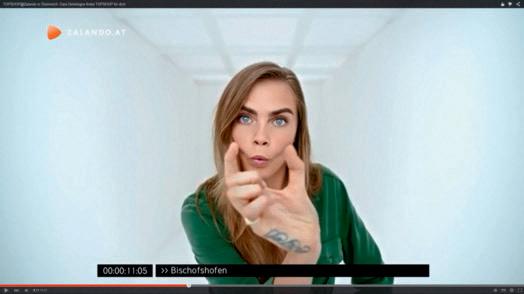
The Zalando x Topshop campaign with supermodel Cara Delevingne contributed to Zalando being perceived differently by the public.
is highly emotional. One has to think about it in-depth, similar to music. Today, some music platforms provide a personal, highly relevant selection despite the fact that there are millions of songs out there. We want to apply such an approach to the world of fashion and successfully highlight the relevant topics to the customers. They need to be topics that really interest the customers on a personal level.
The perception of Zalando has undergone an enormous transformation. What role do measures such as the reduc tion of the brand portfolio or the advertising campaign with Cara Delevingne play for the changing image of Zalando? How does it affect the way people speak about Zalando?
We want to co-operate with the best brands and highlight the newest topics at an early stage, mainly to address a fashion-conscious and informed clientele. Topshop and Gap, which we persuaded to become brand partners this year, are excellent exam
ples for this strategy. It is difficult to access these particular brands in Germany. Our topics, as well as the way we communicate, speak a very different language than they did one or two years ago, even in terms of advertising campaigns. In the past, we mainly focused on brand awareness and therefore enjoy 90% brand recognition in almost all core markets. We really stepped up our marketing efforts in 2010. It was loud and there was a lot of shouting involved, which worked brilliantly. Now we want to take the next step. We no longer want mere awareness; we want to persuade fashion enthusiasts to get to know us better and gain new fans. This is not only reflected by our fashion orientation, but also by the fact that we have turned our back on one-way communication via loud advertisements in favour of focusing on an enhanced dialogue with our customers. That was also the case when he created the Topshop campaign with Cara Delevingne. It led to much more customer feedback, either by pure imitation or via comments. We had online campaign hubs that allowed customers to type in their own city – the city name was then repeated by Cara herself and one could share the result with friends. Our current campaign is focused on the motto “Share your Style”. Customers can upload photos and have others vote on whether they should wear that particular outfit or not. The result is a completely different form of interaction.
Brand awareness, brand image, customer communica tion - what is the next stage of Zalando’s evolution?
Right now we are, of course, primarily a retailer. We select items, purchase goods, go through our internal processes, and sell the products. In the future we want to be the platform that makes it possible to address each customer individually. Everyone should be given the opportunity to follow the topics and brands that are most relevant for him/her and perhaps share that selection with
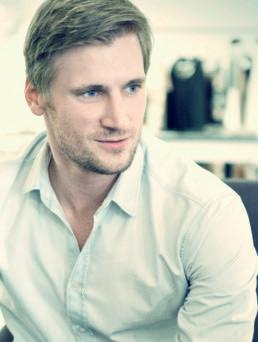

friends. This would enable us to create a fashion network that understands the customers and the way they want to experience fashion. In this respect, we pursue all lines of thought. The Bread & Butter trade show, for instance, is aimed at providing customers with a physical platform to experience fashion. Brands, on the other hand, are afforded the possibility to present their products in an excellent environment.
The main aspect of the Bread & Butter acquisition was obtaining an internationally protected name and a coveted lease. Is the ongoing debate about the Tempelhof airport a welcome opportunity to spend more time on the concept? And should the event be linked with the Fashion Week? The latter is scheduled for July, which is not necessarily ad vantageous.
That was force majeure, to be honest. We were on the verge of discussing our plans regarding the Bread & Butter event, but it goes without saying that there are now more important issues to deal with and that we need to support the process as best we can. Seeing that it remains unclear how the political situation will develop until next summer, we have decided to wait and see what happens for now. We also need to monitor the development of the Berlin Fashion Week. We believe that Berlin has a lot to offer in terms of setting itself apart from Milan, Paris, and London and trying something new. We want to help shape the location.
As what kind of company do you want to define yourself in the future? What are your objectives regarding growth potential and technological possibilities?
That is a difficult question. We have technology, we have fashion, and we have the operational aspect. All three are important and interact. We see a strong differentiation in the investment in technology. If we want to solve all fashion problems, we need the necessary technology and a large number of experts to develop it. However, we also need to remain extremely agile. We need to create the right culture to ensure that the various areas remain independent. We also need to attract talent - for instance with our new tech-sites in Dublin and Helsinki - and create an agile structure that motivates our employees to innovate.
Zalando is very technology-oriented and only recently acquired a stake in a software company named Anatwine. What role do we humans play in the face of so much tech nology?
Anatwine enables brands to connect their own shop and deliver directly to their customers, as well as offering tools to manage the content and the store in general. It works its way into the brands’ systems and creates an interface to Zalando. That supports our vision and expands
our technological possibilities. However, fashion remains an emotional field. Humans don’t want to buy from a machine; they want to follow interesting individuals and be inspired by them. In terms of e-commerce, the first ignition stage was focused on accessibility. This accessibility has now been established. Everyone is online and there are offers everywhere. Everything that was developed by the retail industry over decades - where should I build my store, how do I address passing trade, what does the customer notice in the store (even in terms of smell), how can I offer personal advice, and so on - can be transferred to e-commerce. Ultimately, it boils down to the fact that customers want to feel content and experience fashion as an emotional product.
Technology is a problem solver, but returns remain the biggest challenge for e-com merce. How can you solve that problem realistically?
Returns are an integral part of our business; we don’t see them as a problem. You have to try on clothes before making a decision, just like in every store. What we don’t want are returns that were caused by incorrect product descriptions, sub-par product images, bad service, or inferior quality. Those are the returns we need to avoid. However, the returns caused by the fact that customers order a selection to decide at home are perfectly fine in our eyes. In some countries, especially those that have little experience in terms of e-commerce, we even stress that the possibility of returning all goods is a central element of our service range.
The other major problem of e-commerce is data security. More and more customers want to know what businesses do with the personal informa tion they collect. How can one make customers feel safer?
That’s a sensitive topic. Of course we want to use customer-related information to improve our service. The best example: If I want to personalise, I need to know what the customers wants and monitor what they look at, what they are interested in, and then analyse the correlations. This allows you to create a much
better and more personalised selection. At our advice platform Zalon, the stylist even phones the customers to ask for specific data such as favourite brands and patterns. In the case of local offers, one could even evaluate where the customer is located to improve the offer selection. However, one needs to offer customers conscious choices that allow them to deselect personalised services. It also goes without saying that we never pass on data to third parties, unless it is absolutely necessary. One of those exceptions is, for instance, when we need to pass on an address in the event of a brand delivering to the customer directly.
Currently there are a lot of online shops out there, but the market will experience a clean-up at some point. Where do you see the market, as well as the connections between online and offline, in ten years time?
When you consider where we were five years ago, it becomes clear that quite a lot can happen in ten years. I find it extremely exciting to see how dramatically - and quickly - customer behaviour is changing due to the use of mobile devices. People suddenly no longer utilise browsers, but focus on apps. This causes the market to consolidate increasingly. When I look at a start screen, there is only a limited space for the apps I actually use and that are relevant for me personally. So I won’t have ten shopping apps on that start screen, even if everyone else offers one too. That means that there is a competition as to who makes it onto that start screen and who doesn’t. It’s quite similar to the offline world really. Who builds the shopping street, who is the large flagship store, who is the smaller retailer, and who gets which location? That doesn’t mean that everything else is no longer of use or dies out, but it means that there are different roles to be played and that the market conditions will be different. We perceive ourselves as the ones who build the shopping streets, offer the customers access, have a large reach, and act as the technological enablers. We create an infrastructure to, for instance, allow retailers that have a very specific target group and are geographically limited to access customers that are part of a mobile online world. Currently it is still chaos out there, because everybody strives to be online and mobile. In the long term, the situation will become clearer, especially when offline and online start to interact more. This will open up an enormous amount of exciting opportunities, even for smaller retailers and brands.
Zalando SE Founded in 2008 in Berlin, Germany Management board: Robert Gentz, David Schneider, Rubin Ritter Seed capital: 50,000 Euros Revenue: 2.2 billion Euros (2014) Employees at the end of 2008: 40 Employees at the end of 2015: more than 9,000 Average employee age: 30 Active customers: 16.4 million Online shop visits: 135 million per month Percentage of visits via mobile devices: 57 percent Photo content creation per day: 1,000
